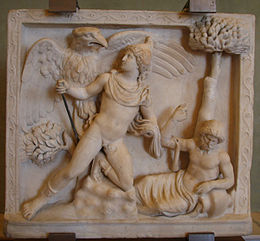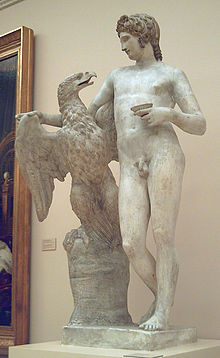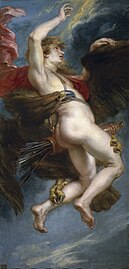Ganymede (mythology)
| Ganymede | |
|---|---|
Cupbearer to the gods | |
 Roman marble bust depicting Ganymede, dating to the 2nd century, now at the Louvre | |
| Abode | Mount Olympus |
| Personal information | |
| Parents | Tros and Callirhoe or Acallaris |
| Siblings | Ilus, Assaracus, Cleopatra, Cleomestra |
In
[Ganymedes] was the loveliest born of the race of mortals, and therefore
the gods caught him away to themselves, to be Zeus' wine-pourer,
for the sake of his beauty, so he might be among the immortals.
The myth was a model for the Greek social custom of paiderastía, the romantic relationship between an adult male and an adolescent male. The Latin form of the name was Catamitus (and also "Ganymedes"), from which the English word catamite is derived.[4] Socrates says that Zeus was in love with Ganymede, called "desire" in Plato's Phaedrus.[5] According to Dictys Cretensis, Ganymede was abducted by the Cretans.[6]
Family
In Greek mythology, Ganymede is the son of
Other details about Ganymede differ as well. Some authors called him a son of
According to
| Relation | Names | Sources | |||||||||||
|---|---|---|---|---|---|---|---|---|---|---|---|---|---|
| Homer | Homeric Hymns | Euripides | Diodorus | Cicero | Dionysius | Apollodorus | Hyginus | Dictys | Clement | Suda | Tzetzes | ||
| Parentage | Tros ♂ | ✓ | ✓ | ✓ | ✓ | ✓ | ✓ | ✓ | |||||
| Acallaris ♀ | ✓ | ||||||||||||
| Callirhoe ♀ | ✓ | ||||||||||||
| Laomedon ♂ | ✓ | ✓ | |||||||||||
| Erichthonius ♂ | ✓ | ||||||||||||
| Assaracus ♂ | ✓ | ||||||||||||
| Dardanus ♂ | ✓ | ||||||||||||
| Ilus ♂ | ✓ | ||||||||||||
| Siblings | Ilus | ✓ | ✓ | ✓ | ✓ | ✓ | |||||||
| Assaracus | ✓ | ✓ | ✓ | ✓ | |||||||||
| Cleopatra | ✓ | ||||||||||||
| Cleomestra | ✓ | ||||||||||||
Mythology

According to the myth, Zeus saw and fell in love with a beautiful mortal youth by the name Ganymede. Ganymede was abducted by Zeus from Mount Ida near Troy in Phrygia.[a] Ganymede had been tending sheep, a rustic or humble pursuit characteristic of a hero's boyhood before his privileged status is revealed, when an eagle transported the youth to Mount Olympus. The bird is sometimes described as being under the command of Zeus and sometimes as being Zeus himself.[23]
On Olympus, Zeus granted Ganymede eternal youth and immortality as the official cup bearer to the gods, in place of Hebe, who was relieved of cup-bearing duties upon her marriage to Herakles. Alternatively, the Iliad presented Hebe (and at one instance, Hephaestus) as the cup bearer of the gods with Ganymede acting as Zeus's personal cup bearer.[24][25] Edmund Veckenstedt associated Ganymede with the creation of mead, which had a traditional origin in Phrygia.[26] In various literature such as the Aeneid, Hera, Zeus's wife, regards Ganymede as a rival for her husband's affection.[27] In various stories, Zeus later put Ganymede in the sky as the constellation Aquarius (the "water-carrier" or "cup-carrier"), which is adjacent to Aquila (the Eagle).[28] In recognition of this myth, the largest moon of the planet Jupiter (named after Zeus's Roman counterpart) was named Ganymede by the German astronomer Simon Marius.[29]

In the Iliad, Zeus is said to have compensated Ganymede's father Tros with the gift of fine horses, "the same that carry the immortals", delivered by the messenger god Hermes.[30] Tros was consoled that his son was now immortal and would be the cupbearer for the gods, a position of much distinction.

In poetry, Ganymede became a symbol for the beautiful young male who attracted homosexual desire and love. He is not always portrayed as acquiescent. However, in the Argonautica of Apollonius of Rhodes, Ganymede is furious at the god Eros for having cheated him at the game of chance played with knucklebones, and Aphrodite scolds her son for "cheating a beginner".[34] The Augustan poet Virgil portrays the abduction with pathos: the boy's aged tutors try in vain to draw him back to Earth, and his hounds bay uselessly at the sky.[35] The loyal hounds left calling after their abducted master is a frequent motif in visual depictions and is referenced by Statius:
Here the Phrygian hunter is borne aloft on tawny wings, Gargara’s range sinks downwards as he rises, and Troy grows dim beneath him; sadly stand his comrades; vainly the hounds weary their throats with barking, pursue his shadow or bay at the clouds.[36]
In the arts
Ancient visual arts

In 5th-century Athens, the story of Ganymede became popular among vase-painters, which was suited to the all-male symposium.[38] Ganymede was usually depicted as a muscular young man, although Greek and Roman sculpture typically depicted his physique as less developed than athletes'.[39]
One of the earliest depictions of Ganymede is a red-figure
Ganymede and Zeus in the guise of an eagle were a popular subject on Roman funerary monuments with at least 16 sarcophagi depicting this scene.[39]
The Carthage Paleo-Christian Museum has a fifth-century Roman statue of Ganymede.[42]
Renaissance and Baroque
Ganymede was a major symbol of homosexual love in the visual and literary arts from the Renaissance to the Late Victorian era, until when Antinous, the reported lover of the Roman Emperor Hadrian, became a more popular subject.[43]
In Shakespeare's

Allusions to Ganymede occur with some frequency in 17th-century Spanish theater. In El castigo sin venganza (1631) by Lope de Vega, Federico, the son of the Duke of Mantua, rescues Casandra, his future stepmother, and the pair will later develop an incestuous relationship. To emphasize the non-normative relation, the work includes a long passage, possibly an ekphrasis derived from Italian art, in which Jupiter in the form of an eagle abducts Ganymede.[46] Two plays by Tirso de Molina, in particular La prudencia en la mujer, include intriguing references to Ganymede. In this particular play, a Jewish doctor who seeks to poison the future king, carries a cup which is compared to Ganymede's.[47]
One of the earliest surviving non-ancient depictions of Ganymede is a woodcut from the first edition of
Examples of Ganymede in 18th-century France have been studied by Michael Preston Worley.[52] The image of Ganymede was always that of a naive adolescent accompanied by an eagle, and the homoerotic aspects of the legend were rarely dealt with. In fact, the story was often more sexualized. The Neoplatonic interpretation of the myth, also common in the Italian Renaissance, the rape of Ganymede, represented the ascent to spiritual perfection. These however seemed to be of no interest to Enlightenment philosophers and mythographers. Jean-Baptiste Marie Pierre, Charles-Joseph Natoire, Guillaume II Coustou, Pierre Julien, Jean-Baptiste Regnault and others contributed images of Ganymede to French art during this period.
Gallery
- Ganymede in Renaissance and Baroque art
-
The Rape of Ganymede (1611–1612) by Rubens, Liechtenstein Museum
-
The Rape of Ganymede (1636–1638) by Rubens, Prado
-
The Rape of Ganymede (1635) by Rembrandt
-
The Induction of Ganymede in Olympus (1768) by van Loo
-
Ganymède Médicis (1684–1685) by Pierre Laviron at Versailles.
Modern



- José Álvarez Cubero's sculpture of Ganymede, executed in Paris in 1804, brought the Spanish sculptor immediate recognition as one of the leading sculptors of his day.[53]
- Vollmer's Wörterbuch der Mythologie aller Völker,[54] (Stuttgart, 1874) illustrates "Ganymede" by an engraving of a "Roman relief", showing a seated bearded Zeus who holds the cup aside to draw a naked Ganymede into his embrace. That engraving however was nothing but a copy of Raphael Mengs's counterfeit Roman fresco, painted as a practical joke on the eighteenth-century art critic Johann Winckelmann who was growing desperate in his search for homoerotic Greek and Roman antiquities. This story is very briefly told by Goethe in his Italienische Reise.[55]
- At Chatsworth in the nineteenth century the bachelor Duke of Devonshire added to his sculpture gallery Adamo Tadolini's Neoclassic "Ganymede and the Eagle", in which a luxuriously reclining Ganymede, embraced by one wing, prepares to exchange a peck with the eagle. The delicate cup in his hand is made of gilt-bronze, lending an unsettling immediacy and realism to the white marble group.
- In the early years of the twentieth century, the topos of Ganymede's abduction by Zeus was drafted into the service of commercial enterprise. Adapting an 1892 lithograph by Budweiserbeer. Collectibles featuring the graphics of the poster continued to be produced into the early 1990s.
- The poem “Goethe was set to music by Franz Schubertin 1817; published in his Opus 19, no. 3 (D. 544). Also set by Hugo Wolf.
- The Portuguese sculptor António Fernandes de Sá represented the abduction of Ganymede in 1898. The sculpture can be found in Jardim da Cordoaria, in Porto (Portugal).
- In stories by belongs. Wodehouse named it after Ganymede presumably in reference to his role of cup-bearer.
- Ganymede is a reluctant music fan in Kurtis Blow's 1980 song "Way Out West". After hours of rap by "The Stranger" (Kurtis), he eventually gets up to dance.
- American artist Washington D.C.c. 1900, depicting an adolescent, nude Ganymede on the back of an eagle.
- Ganymede and the god . Ganymede is described as attracting both males and females.
My first thought, my first flash was that it was a beautiful woman.... The angel was beautiful, with a face dominated by immense, lustrous green eyes and framed by golden ringlets, and with a bow mouth and full lips and brilliant white teeth.
And only then, only after I had felt that first rush of improbable carnal lust, did it occur to me that this angel was a man.[56]
- In 1959 Robert Rauschenberg referenced the myth in one of his best-known works, Canyon and in another work, Pail for Ganymede. In "Canyon", a photo of Rauschenberg's son Christopher beautifully reiterates the infant portrayed by Rembrandt in the 17th century. A stuffed eagle emerges from the flat picture plane with a pillow tied to a piece of string very near his claw. The pillow also reflects upon the young boy's body and Rembrandt's painting.
- Ganymede is a reluctant son in W. H. Auden's poem of that name, but he adores the eagle which teaches him how to kill.
- Felice Picano's 1981 novel An Asian Minor reinvents the story of Ganymede.
- In the 2016 video game Overwatch, the character Bastion has a bird named Ganymede.
- A character in the Terra Ignotaseries by Ada Palmer is named Ganymede de la Trémoille
- The opening of Phonerefers to 'agents of Ganymede' (p. 6) to explore caution within the homosexual community in previous decades.
- The first poem in Jericho Brown's Pulitzer Prize for Poetry-winning 2019 book The Tradition is titled "Ganymede". Brown, who frequently interrogates topics of sexuality and race, brings the Greek abduction myth into contact with the history of American slavery.
- In 2023's Percy Jackson and the Chalice of the Gods, the sixth novel of the Percy Jacksonseries, Ganymede presents Percy Jackson with his first quest to retrieve the stolen Chalice of the Gods.
Family tree
Notes
References
- ^ "Ganymede". Oxford English Dictionary (Online ed.). Oxford University Press. (Subscription or participating institution membership required.)
- ^ "Ganymedes". Dictionary.com Unabridged (Online). n.d.
- Lattimore, Richard, trans. The Iliad of Homer. Chicago: University of Chicago Press, 1951.
- AMHER(2000), catamite, p. 291.
- ^ "Plato: Phaedrus". Perseus Digital Library. 255c. Retrieved 7 February 2023.
- ^ Cretensis, Dictys. "2.26". www.theoi.com. Retrieved 11 January 2024.
- ^ Diodorus Siculus, Bibliotheca historica 4.75.3–5
- ^ Homer, Iliad 20.230–240
- ^ Suda v.s. Minos
- Tzetzes on Lycophron, 29
- ^ Scholiast on Homer's Iliad 20.231 who refers to Hellanicus as his authority
- ^ Pseudo-Apollodorus, Bibliotheca 3.12.2
- ^ Dionysius of Halicarnassus, Antiquitates Romanae 1.62.2
- ^ Dictys Cretensis, Trojan War Chronicle 4.22
- ^ Cicero, Tusculanae Disputationes 1.65
- ^ Euripides, Troad 822
- ^ Tzetzes ad Lycophron 34
- ^ Clement of Alexandria, Recognitions 22
- ^ Hyginus, Fabulae 271
- ^ Hyginus, Fabulae 224
- ^ Veckenstedt, Johann Albrecht Edmund (1882). Ganymedes: Als Beilage Zu D. Nachrichten uber den Bestand und die Thatigkeit des Nicolai-Gymnasiums zu Liben im Laufe des Jahres 1881. Liepaja: Verlag von Rudolph Puhze. p. 10.
- ^ Strabo. "Geography 13.1.11". Perseus Digital Library. Tufts University. Retrieved 19 March 2020.
- ^ Virgil, Aeneid, 5.252
- ^ Homer, Iliad 20.230
- JSTOR 294813.
- ^ Edmund Veckenstedt, Ganymedes, Libau, 1881.
- ^ Virgil, Aeneid, 1.28
- ISBN 978-1682682111.
- ^ Marius/Schlör, Mundus Iovialis, p. 78 f. (with misprint In for Io)
- ^ The Achaean Diomedes is keen to capture the horses of Aeneas because "...they are of that stock wherefrom Zeus, whose voice is borne afar, gave to Tros recompense for his son Ganymedes, for that they were the best of all horses that are beneath the dawn and the sun.": Homer, Iliad 5.265ff.
- ^ Plato, Laws 636D, as cited by Thomas Hubbard, Homosexuality in Greece and Rome, p252
- ^ S2CID 159630527.
- ^ Xenophon, Symposium 8.29–30; Craig Williams, Roman Homosexuality (Oxford University Press, 1999, 2010), p. 153.
- ^ Apollonius Rhodius, Argonautica 3.112
- ^ Virgil, Aeneid 5.256–7.
- ^ Statius, Thebaid 1.549.
- ^ For the cockerel as an emblematic gift to the eromenos, see, for example, H. A. Shapiro, "Courtship scenes in Attic vase-painting", American Journal of Archaeology, 1981; the gift is "gender specific, and it is clear that the cock had significance as evocative of male potency", T. J. Figueira observes, in reviewing two recent works on Greek pederasty, in American Journal of Archaeology, 1981.
- ^ ISBN 978-0801481642.
- ^ JSTOR 4238454.
- ^ "www.louvre.fr".
- JSTOR 44137123.
- ^ "Roman Statue Stolen From Carthage - Archaeology Magazine". www.archaeology.org. Retrieved 14 March 2024.
- JSTOR 3704122.
- S2CID 153554373.
- JSTOR 24322350.
- Correggio and Lope de Vega's El castigo sin venganza” Bulletin of the Comediantes 59.2 (2008): 233–65.
- ^ Felipe E. Rojas, "Representing An-'Other' Ganymede: The Multi-Faceted Character of Ismael in Tirso de Molina's La prudencia en la mujer (1634)," Bulletin of Hispanic Studies (2014): 347–64.
- ^ S2CID 201783650.
- ^ {https://www.wga.hu/frames-e.html?/html/r/rubens/21mythol/10mythol.html Peter Paul Rubens, The Abduction of Ganymede] in the Liechtenstein Museum
- ^ Peter Paul Rubens, The Rape of Ganymede in the Museo del Prado
- ^ Barfoot, C. C.; Todd, Richard. The Great Emporium : the Low Countries as cultural crossroads in the Renaissance and the eighteenth century. Amsterdam: Editions Rodopi B.V.
- ^ Worley, "The Image of Ganymede in France, 1730–1820: The Survival of a Homoerotic Myth," Art Bulletin 76 (December 1994: 630–643).
- ^ One or more of the preceding sentences incorporates text from a publication now in the public domain: Chisholm, Hugh, ed. (1911). "Alvarez, Don José". Encyclopædia Britannica (11th ed.). Cambridge University Press.
- ^ "Vollmer-mythologie.de". Vollmer-mythologie.de. Retrieved 22 January 2014.
- ^ "Textlog.de". Textlog.de. Retrieved 22 January 2014.
- Applegate, K. A., Everworld VI: Fear the Fantastic, p. 50.
Sources
Ancient sources
Ganymede is named by various ancient Greek and Roman authors:
- Homer – Iliad 5.265; Iliad 20.232;
- Homerica – The Little Iliad, Frag 7;
- Homeric Hymns – Hymn V, To Aphrodite, 203–217;
- Theognis– Fragments 1.1345;
- Pindar – Olympian Odes 1; 11;
- Iphigenia at Aulis1051;
- Plato – Phaedrus 255; Laws 636c
- Apollonios Rhodios – Argonautica3.112f;
- ps-Apollodorus – Bibliotheke 2.104; 3.141;
- Strabo – Geography 13.1.11;
- Pausanias – Guide to Greece V.24.5; V.26.2–3;
- Diodorus Siculus – The Library of History 4.75.3;
- Hyginus
- Fabulae 89; 224; 271;
- Astronomica 2.16; 2.29;
- Metamorphoses10.152;
- Virgil – Aeneid 1.28; 5.252;
- Cicero – De Natura Deorum 1.40;
- Valerius Flaccus– Argonautica 2.414; 5.690;
- Statius
- Apuleius – The Golden Ass 6.15; 6.24;
- Quintus Smyrnaeus – Fall of Troy 8.427; 14.324;
- Nonnus – Dionysiaca 8.93; 10.258; 10.308; 12.39; 14.430; 15.279; 17.76; 19.158; 25.430; 27.241; 31.252; 33.74; 39.67; 47.98;
- Suda – Ilion; Minos;
Modern sources
- This article incorporates text from a publication now in the public domain: Chisholm, Hugh, ed. (1911). "Ganymede". Encyclopædia Britannica. Vol. 11 (11th ed.). Cambridge University Press. p. 454.
External links
- World History of Male Love: Zeus and Ganymede
- The Zeus and Ganymede Myth: Analysis and Resources by Andrew Calimach
- Ganymedes, Theoi Project
- Ganymede: Subject of the Visual Arts
- Goethe, "Ganymed" Archived 30 November 2015 at the Wayback Machine (in German)
- The Warburg Institute Iconographic Database (images of Ganymede)







